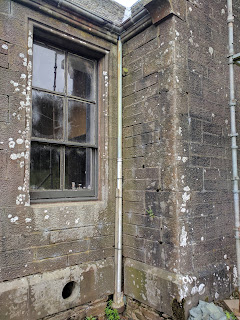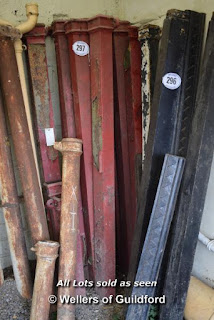While replacing the third of three plastic downpipes on the exterior of the kitchen wing with cast iron ones, we hit a problem. The ground was dug up at the foot of the new downpipe so we could connect it up. However, the drain here was simply not draining. It looks like the rain from the roof has just been soaking into the ground rather than being taken way - probably for many years.
I stuck my hand down the drain and pulled out as much earth as I could. This did not unblock it. :-( The drain pipe seemed to be going under the castle rather than away from the castle. Gregor and Greg excavated round the drain, and the first section of pipe appeared to be a trap. The trap had a U-bend, but as the U went up again the pipe was fractured. The crack was around 15mm wide, enough to let earth in and block things. Gregor shoved a length of thin but rigid plastic into the crack and wiggled. This just did enough to unblock the drain and we could hear the water drain away with an echo-y splash into the underground tank in the middle of the service courtyard.
After much debate we reasoned that we would have to either seal the crack or install a new drain, because if we did nothing the earth blockage would recur. In any case, the crack meant that a significant amount of water, perhaps the majority, entered the ground.
Greg excavated around the ceramic trap to free it, and with much digging in hard stony ground and with much wiggling, it finally came loose. You can see from the picture of the trap below that the crack is at an angle and that re-joining would be next to impossible.
 |
| the original Victorian trap with cracked U bend |
Reluctantly we replaced the trap with an inpection chamber which arrived with Plumbageddon, a mass purchase of plumbing bits and bobs. Plumbaggedden, described in an earlier blog entry, was starting to pay dividends.
The inspection chamber outlet was connected by a rubber adapter to where the old trap was connected - once the salt glaze pipe was given a neat vertical edge using a saw. The input pipes were at a higher level so could not be fed into the inlets but instead fed-in from above. Here you can see the kitchen sink drain - a white plastic pipe inside the original lead pipe and the land drainage pipe from the area around the kitchen - which terminates in a 90 degree grey bend.
 |
| replacement inspection chamber |
The next picture shows the new connection from the square downpipe; two black riser chambers and a cast iron manhole cover. All bits courtesy of Plumbageddon. All that remains to be added are three inspection chamber inlet blanks, and then we can back-fill the hole. For once Plumbageddon did not oblige, and I had to order the blanks from the Internet.
 |
| fully connected inspection chamber with risers and manhole cover |
The final image shows the third of the three newly installed cast iron downpipes, with the newly installed drain. Hurrah! Having to rework the drainage was totally unexpected, and took a couple of days. Moral was low at the end of yesterday as we had not been able to unblock the drain, did not know what was happening underground, and had no idea how to solve the problem. So from the high of seeing the third cast iron downpipe installed, we were then cast down by not knowing how we could ever get it to work. Apparent forward progress can actually make one realise that one has actually gone backwards. :-(
 |
| new cast iron downpipe and new drainage to handle the water properly |
Yes, the new drain is sticking out of the ground at the moment. However, the top riser chamber will be cut down to meet the final ground level, once this has been established.









